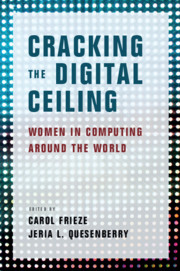Book contents
- Cracking the Digital Ceiling
- Cracking the Digital Ceiling
- Copyright page
- Contents
- Contributors
- Acknowledgments
- Introduction
- Part I Global Perspectives
- 1 An Inegalitarian Paradox
- 2 A Global Perspective on Women in Information Technology
- 3 Field Studies of Women in Europe, North America, Africa, and Asia-Pacific
- Part II Regional Perspectives
- Part III Cultural Perspectives from the United States and Europe
- Part IV Cultural Perspectives from Asia-Pacific
- Conclusion
- Notes
- Index
- References
2 - A Global Perspective on Women in Information Technology
Perspectives from the “UNESCO Science Report 2015: Towards 2030”
from Part I - Global Perspectives
Published online by Cambridge University Press: 10 October 2019
- Cracking the Digital Ceiling
- Cracking the Digital Ceiling
- Copyright page
- Contents
- Contributors
- Acknowledgments
- Introduction
- Part I Global Perspectives
- 1 An Inegalitarian Paradox
- 2 A Global Perspective on Women in Information Technology
- 3 Field Studies of Women in Europe, North America, Africa, and Asia-Pacific
- Part II Regional Perspectives
- Part III Cultural Perspectives from the United States and Europe
- Part IV Cultural Perspectives from Asia-Pacific
- Conclusion
- Notes
- Index
- References
Summary
In 2015 the United Nations Educational, Scientific and Cultural Organization (UNESCO) published the latest edition of its Science Report. Published every five years, the Science Report maps the status of science, technology, and innovation and governance around the world. The 2015 edition was conceived as a response to the Sustainable Development Goals (SDGs) and the 2030 Agenda, which recognizes the role of science, technology, and innovation as an important contributor to global sustainability. This edition also included the first globally comprehensive presentation and analysis of global data on women’s representation in science and technology outside Europe and North America. This chapter contains an overview of the main findings of the 2015 UNESCO Science Report chapter “Is the Gender Gap Narrowing in Science and Engineering?,” as well as recent analysis of the factors encouraging and constraining women’s participation in STEM fields globally.
- Type
- Chapter
- Information
- Cracking the Digital CeilingWomen in Computing around the World, pp. 46 - 60Publisher: Cambridge University PressPrint publication year: 2019



